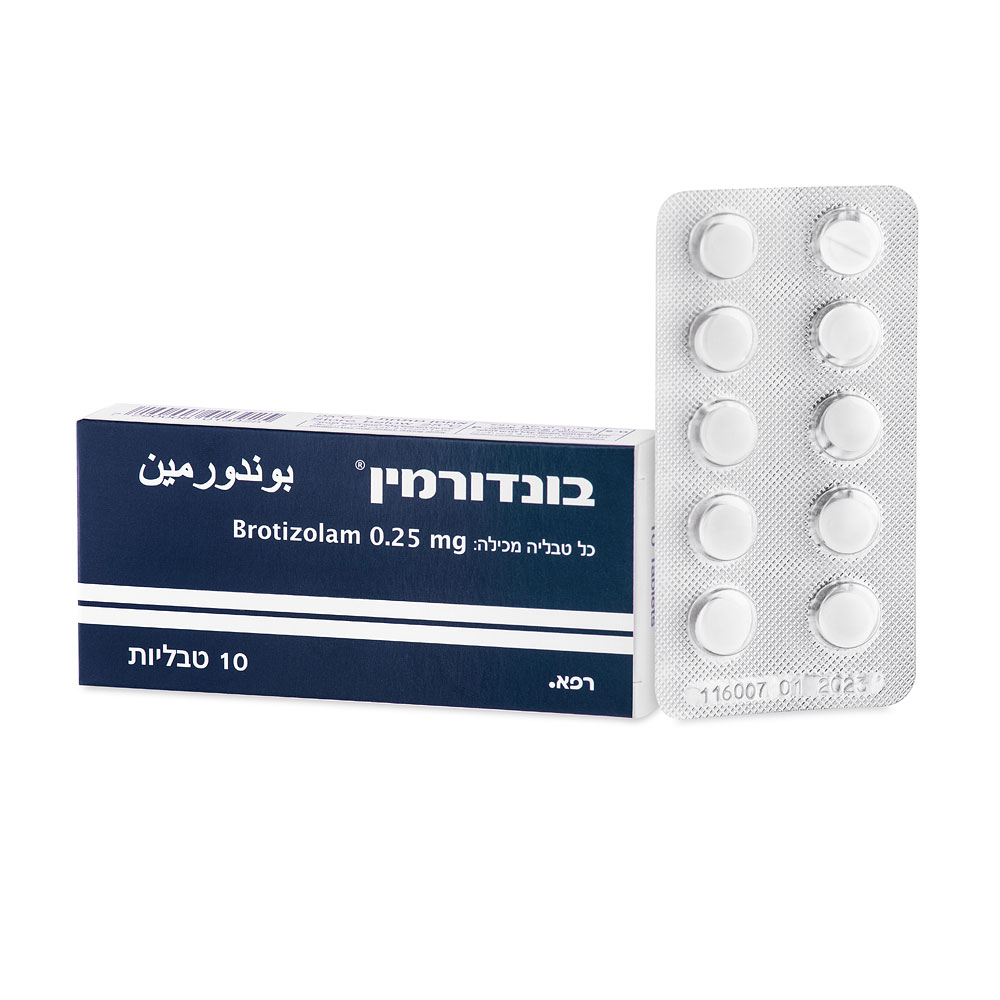Quest for the right Drug

בונדורמין BONDORMIN (BROTIZOLAM)
תרופה במרשם
תרופה בסל
נרקוטיקה
ציטוטוקסיקה
צורת מתן:
פומי : PER OS
צורת מינון:
טבליה : TABLETS
עלון לרופא
מינוניםPosology התוויות
Indications תופעות לוואי
Adverse reactions התוויות נגד
Contraindications אינטראקציות
Interactions מינון יתר
Overdose הריון/הנקה
Pregnancy & Lactation אוכלוסיות מיוחדות
Special populations תכונות פרמקולוגיות
Pharmacological properties מידע רוקחי
Pharmaceutical particulars אזהרת שימוש
Special Warning עלון לרופא
Physicians Leaflet
Interactions : אינטראקציות
4.5 Interaction with other medicinal products and other forms of interaction Alcohol should be avoided during treatment with brotizolam as it modifies and increases the effects of brotizolam in an unpredictable manner (see section 5.2). Concurrent use of brotizolam and alcohol can potentiate sedation, drowsiness and impaired concentration (see also "Interactions with alcohol", section 5.2). Co-administration of brotizolam with other CNS depressants (antipsychotics (neuroleptics), antidepressants, hypnotics, anxiolytics/sedatives, narcotic analgesics, anaesthetics, anti-epileptics and sedative antihistamines) can lead to mutual enhancement of the CNS depressant effect and therefore requires very careful consideration. Concurrent use of sedating medications (benzodiazepines or related medicines such as Bondormin) with opioids increases the risk of sedation, respiratory depression, coma and death due to an additive CNS depressant effect. The dosage and duration of concurrent use should be limited (see section 4.4). Co-administration of brotizolam with narcotic analgesics can lead to enhancement of the euphoria and accelerate the development of dependence. The nature and extent of interactions between brotizolam and other medicinal products (antidiabetics, antihypertensives, cardiac glycosides and hormones) varies unpredictably between individuals and caution is therefore required when giving Bondormin to patients taking these products. Co-administration of brotizolam with muscle relaxants can increase the muscle relaxant effect. Brotizolam is metabolised chiefly by the cytochrome P450 isoenzyme CYP 3A4 in the liver. Agents that compete with brotizolam for CYP 3A4 (competitive inhibition) and agents that inhibit CYP 3A4 can therefore increase the effect of brotizolam. Known substrates for CYP 3A4 include astemizole, azole antifungals (such as itraconazole and ketoconazole), immunosuppressants (such as ciclosporin A, sirolimus and tacrolimus), calcium antagonists, macrolide antibiotics (such as clarithromycin and erythromycin), antimalarials (such as halofantrine and mefloquine), midazolam, pimozide, protease inhibitors (such as indinavir, nelfinavir and ritonavir), sildenafil, statins (such as atorvastatin, lovastatin and simvastatin), steroids (such as ethinyl-estradiol), tamoxifen and terfenadine. Inhibitors of CYP 3A4, which can increase the toxicity of brotizolam, include azole antifungals, cimetidine, grapefruit juice, macrolide antibiotics and protease inhibitors. Inducers of CYP 3A4, which increase enzyme activity and can reduce the effect of brotizolam, include carbamazepine, efavirenz, St. John's wort, nevirapine, phenobarbital, phenytoin, primidone, rifabutin and rifampicin.

שימוש לפי פנקס קופ''ח כללית 1994
Insomnia
תאריך הכללה מקורי בסל
01/01/1995
הגבלות
תרופה שאושרה לשימוש כללי בקופ'ח
מידע נוסף
